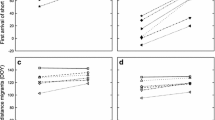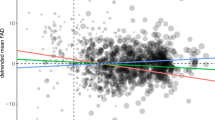Abstract
Coinciding with increasing spring temperatures in Europe, many migrants have advanced their arrival or passage times over the last decades. However, some species, namely long-distance migrants, could be constrained in their arrival dates due to their largely inherited migratory behaviour and thus a likely inflexibility in their response to exogenous factors. To examine this hypothesis for pied flycatchers (Ficedula hypoleuca), we tested the effects of the temperature regimes along their migration routes north of the Sahara on their arrival times in central Europe. To do so, we developed a site-independent large-scale approach based on temperature data available on the Internet. Temperature regimes along the migration routes of pied flycatchers within Europe convincingly correlate with their first arrival times. It can be concluded that the progression of spring migration in this species is strongly influenced by temperature en route. Because of the recent inconsistent climatic changes in various parts of Europe, we hypothesize that individuals migrating along different routes will be unequally affected by further climatic changes.






Similar content being viewed by others
References
Ahola M, Laaksonen T, Sippola K, Eeva T, Rainio K, Lehikoinen E (2004) Variation in climate warming along the migration route uncouples arrival and breeding dates. Glob Change Biol 10:1610–1617
Anthes N (2004) Long-distance migration timing of Tringa sandpipers adjusted to recent climate change. Bird Study 51:203–211
Bairlein F, Hüppop O (2004) Migratory fuelling and global climate change. In: Møller AP, Fiedler W, Berthold P (eds) Advances in ecological research, vol 35. Birds and climate change. Elsevier Science, London, pp 33–47
Bairlein F, Winkel W (2001) Birds and climate change. In: Lozán JL, Graßl H, Hupfer P (eds) Climate of the 21st century: changes and risks. Scientific facts. GEO, Hamburg, pp 278–282
Berthold P (1996) Control of bird migration. Chapman & Hall, London
Berthold P (2001) Bird migration: a general survey, 2nd edn. Oxford University Press, Oxford
Both C, Artemyev AV, Blaauw B, Cowie RJ, Dekhuizen AJ, Eeva T, Enemar A, Gustafsson L, Ivankina EV, Järvinen A, Metcalfe NB, Nyholm NEI, Potti J, Ravussin P-A, Sanz JJ, Silverin B, Slater FM, Sokolov LV, Török J, Winkel W, Wright J, Zang H, Visser ME (2004) Large-scale geographical variation confirms that climate change causes birds to lay earlier. Proc R Soc Lond B 271:1657–1662
Both C, Bijlsma RG, Visser ME (2005) Climatic effects on timing of spring migration and breeding in a long-distance migrant, the pied flycatcher Ficedula hypoleuca. J Avian Biol 36:368–373
Both C, Visser ME (2001) Adjustment of climate change is constrained by arrival date in a long-distance migrant bird. Nature 411:296–298
Cook RD, Weisberg S (1982) Residuals and influence in regression. Chapman & Hall, London
Coppack T, Both C (2002) Predicting life-cycle adaptation of migratory birds to global climate change. Ardea 90:369–378
Cotton PA (2003) Avian migration phenology and global climate change. Proc Natl Acad Sci USA 100:12219–12222
Crick HQP (2004) The impact of climate change on birds. Ibis 146(Suppl 1):48–56
Easterling DR, Horton B, Jones PD, Peterson TC, Karl TR, Parker DE, Salinger MJ, Razuvayev V, Plummer N, Jamason P, Folland CK (1997) Maximum and minimum temperature trends for the globe. Science 277:364–367
Fischer S (2002) Frühjahrsankunft ziehender Singvogelarten in Berlin über 26 Jahre. Berl Ornithol Ber 12:145–166
Gwinner E (1996) Circannual clocks in avian reproduction and migration. Ibis 138:47–63
Hölzinger J (1997) Ficedula hypoleuca (Pallas 1764) Trauerschnäpper. In: Hölzinger J (eds) Die Vögel Baden-Württembergs vol 3.2, Singvögel 2. Ulmer, Stuttgart, pp 63–7
Huin N, Sparks TH (1998) Arrival and progression of the Swallow Hirundo rustica through Britain. Bird Study 45:361–370
Huin N, Sparks TH (2000) Spring arrival patterns of the Cuckoo Cuculus canorus, Nightingale Luscinia megarhynchos and Spotted Flycatcher Muscicapa striata in Britain. Bird Study 47:22–31
Hüppop K, Hüppop O (2004) Atlas zur Vogelberingung auf Helgoland. Teil 2 Phänologie im Fanggarten von 1961 bis 2000. Vogelwarte 42:285–343
Hüppop O, Hüppop K (2003) North Atlantic Oscillation and timing of spring migration in birds. Proc R Soc Lond B 270:233–240
Klein Tank AMG, Können GP (2003) Trends and indices of daily temperature and precipitation extremes in Europe, 1946–1999. J Clim 16:3665–3680
Kok OB, van Ee CA, Nel DG (1991) Day length determines departure date of the spotted flycatcher Muscicapa striata from its winter quarters. Ardea 79:63–66
Lehikoinen E, Sparks TH, Zalakevicius M (2004) Arrival and departure dates. In: Møller AP, Fiedler W, Berthold P (eds) Advances in ecological research, vol 35. Birds and climate change. Elsevier Science, London, pp 1–31
Lundberg A, Alatalo RV (1992) The Pied Flycatcher. Poyser, London
Luterbacher J, Dietrich D, Xoplaki E, Grosjean M, Wanner H (2004) European seasonal and annual temperature variability, trends, and extremes since 1,500. Science 303:1499–1503
Marra PP, Francis CM, Mulvihill RS, Moore FR (2005) The influence of climate on the timing and rate of spring bird migration. Oecologia 142:307–315
Potti J (1998) Arrival time from spring migration in male pied flycatchers: individual consistency and familial resemblance. Condor 100:702–708
Przybylo R, Sheldon BC, Merila J (2000) Climatic effects on breeding and morphology: evidence for climatic plasticity. J Anim Ecol 69:395–403
Rosenfeld J, Fagerström T (1980) Vårflyttningens förlopp över Örskår hos tretton nattflyttande småfåglar. Var Fagelvarld 39:217–224
Saino N, Szép T, Romano M, Rubolini D, Spina F, Møller AP (2004) Ecological conditions during winter predict arrival date at the breeding quarters in a trans-Saharan migratory bird. Ecol Lett 7:21–25
Sanz JJ (2003) Large-scale effect of climate change on breeding parameters of pied flycatchers in Western Europe. Ecography 26:45–50
Schönwiese C-D, Hupfer P (2001) Observed climate change within the 19th and 20th century: Danger ahead? In: Lozán JL, Graßl H, Hupfer P (eds) Climate of the 21st Century: changes and risks. Scientific facts. GEO, Hamburg, pp 101–115
Sokolov LV (2000) Spring ambient temperature as an important factor controlling timing of arrival, breeding, post-fledging dispersal and breeding success of Pied Flycatcher Ficedula hypoleuca in Eastern Baltic. Avian Ecol Behav 5:79–104
Sokolov LV, Kosarev VV (2003) Relationship between timing of arrival of passerines to the Courish Spit and North Atlantic Oscillation index (NAOI) and precipitation in Africa. Proc Zool Inst Russ Akad Sci 299:141–154
Sparks TH, Roberts DR, Crick HQP (2001) What is the value of first arrival dates of spring migrants in phenology? Avian Ecol Behav 7:75–85
Sparks TH, Bairlein F, Bojarinova JG, Hüppop O, Lehikoinen EA, Rainio K, Sokolov LV, Walker D (2005) Examining the total arrival distribution of migratory birds. Glob Change Biol 11:22–30
Stervander M, Lindström Å, Jonzén N, Andersson A (2005) Timing of spring migration in birds: long-term trends, North Atlantic Oscillation and the significance of different migration routes. J Avian Biol 36:210–221
Strode PK (2003) Implications of climate change for North American wood warblers (Parulidae). Glob Change Biol 9:1137–1144
Tryjanowski P, Kuzniak S, Sparks T (2002) Earlier arrival of some farmland migrants in western Poland. Ibis 144:62–68
Vähätalo AV, Rainio K, Lehikoinen A, Lehikoinen E (2004) Spring arrival of birds depends on the North Atlantic Oscillation. J Avian Biol 35:210–216
Walther Y, Bingman VO (1984) Orientierungsverhalten von Trauerschnäppern (Ficedula hypoleuca) während des Frühjahrszuges in Abhängigkeit von Wetterfaktoren. Vogelwarte 32:201–205
Winkel W, Hudde H (1993) Ficedula hypoleuca (Pallas 1764)–Trauerfliegenschnäpper, Trauerschnäpper. In: Glutz von Blotzheim UN (eds) Handbuch der Vögel Mitteleuropas vol 13/I. Aula, Wiesbaden, pp 165–263
Zalakevicius M, Zalakeviciute R (2001) Global climate warming and birds: a review of research in Lithuania. Folia Zool 50:1–17
Zink G (1985) Der Zug europäischer Singvögel. Ein Atlas der Wiederfunde beringter Vögel. 4. Lieferung. Vogelzug, Möggingen
Acknowledgements
We are especially thankful to all persons collecting and providing field data, namely Ute Rahne (Braunschweig), Hans-Hermann Geißler (Hamburg), Stefan Fischer (Berlin) and the almost uncountable number of people working at the Helgoland station. Franz Bairlein, Timothy Coppack, Kathrin Hüppop, Esa Lehikoinen and an anonymous referee provided constructive comments on an earlier draft of our manuscript. Timothy Coppack further polished our English.
Author information
Authors and Affiliations
Corresponding author
Additional information
Communicated by F. Bairlein
Rights and permissions
About this article
Cite this article
Hüppop, O., Winkel, W. Climate change and timing of spring migration in the long-distance migrant Ficedula hypoleuca in central Europe: the role of spatially different temperature changes along migration routes. J Ornithol 147, 344–353 (2006). https://doi.org/10.1007/s10336-005-0049-x
Received:
Revised:
Accepted:
Published:
Issue Date:
DOI: https://doi.org/10.1007/s10336-005-0049-x




